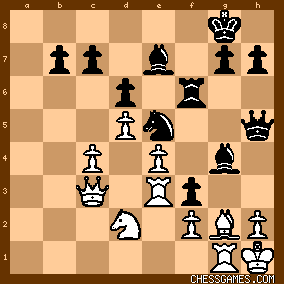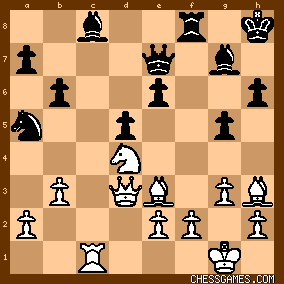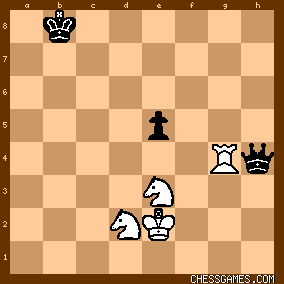David2009

- Brilliant underdogs
|
Here are games where the losing underdog really goes for the winner. Nothing venture nothing win! A difference in grading of 400 ELO points should mean you have a 10% chance of winning. A difference of 200 points means you have a 25% chance. Go for it! In the first game, our underdog boldly goes trapping <Life Master AJ>'s queen - and so nearly pulls it off! In the fourth game, the underdog smashes up F Urkedal in 2013 with the double Muzio gambit. Urkedal is no patzer - Norwegion champion in 2012
|
|
4 games, 1997-2013 - Intriguing endgames
|
This is a selection of endgames which I have particularly liked playing through, because they have caught my imagination. Some are defensive triumphs. Others are wins against the odds. Others are see-saws when the result has fluctuated. Yet others show perseverance winning out in drawn positions, or instructive mistakes.
|
|
9 games, 1946-2012 - NN vs P: unheard melodies
|
The ending Two Knights versus lone Pawn fascinates me. The winning strategy is simple (blockade the defending P with one N; use K and remaining N to shepherd the defending K in a corner; bring over the blockading N to checkmate), it is the tactics - the shepherding of the defending K - that are complicated. Some patterns keep on recurring, but others are unexpected and counter-intuitive. The ending is also very easy for the defender to lose. For example, mechanically trying to stay in the centre of the board does not work. L N Enequist vs M Fish, 1934 and Barcza vs P Rethy, 1953 are examples of wins from initially drawn positions. J Sarkar vs J Urbina Perez, 2011 is a near-victory from a drawn starting position. Topalov vs Karpov, 2000 shows that even former world champions can make defensive mistakes (in rapid play). This game collection only scratches the surface. Like diamonds, many beautiful variations lie below the surface. With grateful thanks to <Resignation Trap> for his splendid collection Game Collection: Two Knights versus Pawn A key defensive resource is knowledge about corners. The distinction is really between corners that are lethal, corners that are dangerous and corners that are safe (because the blockaded Pawn is too far forward). Link: David2009 chessforum (kibitz #26). In A Bisguier vs A Matanovic, 1961 (which shows the struggle of blockaded P on h5 vs NN) White lost quickly by going to the wrong corner (an earlier mistake was voluntarily entering the ending, without which there would have been no story). Another hidden gem: with best play on both sides there was an immensely difficult 50-move-rule draw achieved by heading towards the a8, then a1 and finally h1 corner but never of course entering the first two. In the best-play variation White can claim his 50 move draw with no moves to spare. J Salas Romo vs Eliskases, 1941 ends up as P vs NN and 0-1 but the unheard melody occurs at move 39. 
click for larger view Does 39.Qxe3 dxe3 40.Nd3 draw for White? Here's a trap worth knowing in the following position with White to play (taken from D Komarov vs Kasimdzhanov, 2010

click for larger view
Intuitively the position drawn and, indeed, it should be drawn with best play. But Black can set a devilish trap. After the natural moves 77 Kc1 Ke1 78.Kc2 Ke2 79.Kc1 Black can try 79...Nf2! (the Botvinnk trap, see Smyslov vs Lilienthal, 1941 (kibitz #7)).
Now the natural 80.Kc2 loses to 80...Nd1! (springing the trap). We have reached

click for larger view
which is a position of mutual zugzwang (White to play loses, Black to play draws). To avoid this, White should play 80. Kb2! and Black can choose betwen the mutual zugzwang just discussed or
chasing White with the King, but White can make for b6 via the a file and slip out of the net.
|
|
26 games, 1854-2013 - The talented Mr Ripley
Here are four wins by the late John Ripley, together with his best loss (against Tal). It takes two players to produce a great game!
|
|
5 games, 1967-1974 - Triumph of the underdog
|
Game 1 is a French Defence Exchange Variation. White, outgraded, grabs a pawn - and holds it. Black overpresses. A difference of X ELO points translates into an expected score of approximately (50+X/8) per cent for the stronger side. So a grading difference of 200 translates into 75%:25% (e.g 1 win 1 draw in two games, or 3 wins 1 loss in four games). So upsets happen - but not all that often. In Game 2 White is outgraded by 188 ELO points but is not in the least overawed: he takes the fight to his opponent right from the start (accelerated Panov attack) and reaches a difficult N ending a Pawn up, and sacrifices it back to convert the full point. Game 3 is another French Defence Exchange Variation. White is playing a GM. He tries to take his opponent out of the books and grabs material. By move 14 his position is difficult, by moves 17-22 it looks lost - then Black has an oversight. Game 4 is a mating attack by an outgraded Black: 
click for larger view (Black to play, 26...?) Game 5 shows a logical build-up by the White underdog exploiting Black's ambitious play. The combination proper starts with White to play at move 24:

click for larger viewIn Game 6 Botvinnik, fourteen, beats the World Champion with Black (in a simultaneous). Playing through the game, one asks - where exactly does White go wrong? - he plays natural moves and gets completely smashed (OK, 9.Bxf6 Nxf6 10. O-O-O was decidedly optimistic). In game 7 the game is heading peacefully for a draw

click for larger view
when the grandmaster, Black, inexplicably liquidates into a should-be-drawn ending with 51...Qxg4 52.Nxg4 e4 - and then lost it. There was a theoretical draw by the fifty-move rule but the ending is tricky to defend.
|
|
7 games, 1925-2011
|
|
| SEARCH ENTIRE GAME COLLECTION DATABASE |
use these two forms to locate other game collections in the database

|
|



